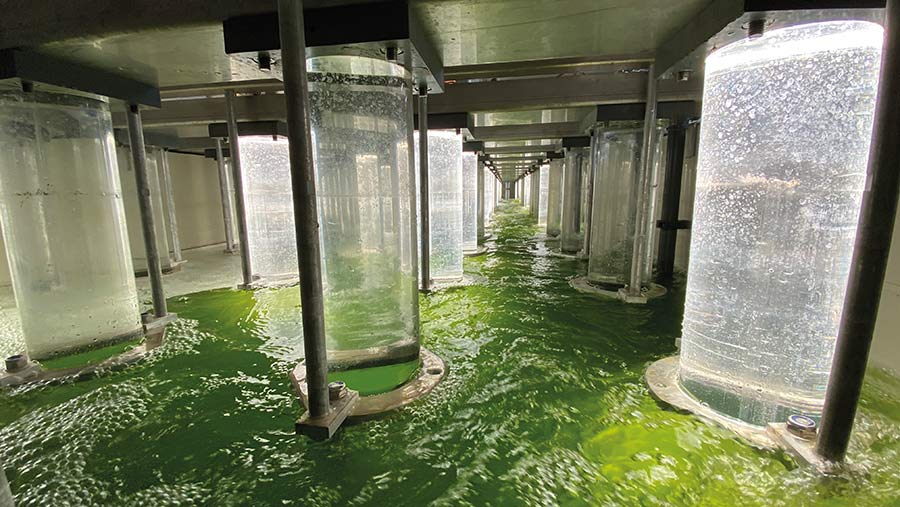New tech to treat farm slurry and produce fertiliser trialled
 © I-Phyc
© I-Phyc The UK’s water treatment industry has been keeping a keen eye on an upcoming technology that promises to revolutionise the way we treat waste water, all without the use of harsh chemicals.
Now, this same technology is set to be trialled within the agricultural sector to lower the ammonia concentration in slurry with the help of an unlikely candidate – micro algae.
See also: How close is hydrogen to being a viable farm machinery fuel?
Water treatment
Engineered by scientists from Bristol-based firm I-Phyc, the algal bioreactor is designed to treat waste water and has the potential to be carbon neutral, if not negative, or offer significant carbon reduction at the least.
It has already been installed on a commercial scale by plants such as Southern Water and Severn Trent, and negotiations are under way with Anglian Water.
“All of the water companies have expressed an interest at some level,” says Matt Baldry, commercial director at I-Phyc.
“The water industry is very conservative, and there’s almost a race to be second where new technologies are concerned.
But, because we tick so many environmental boxes when it comes to carbon and being totally chemical free, we know they are keeping a very close eye on us.”
The system works by using algae to feed on nutrients in waste water, such as phosphorus, ammonia and nitrates, which are consumed as a food source in order to survive, grow and multiply.
Providing it is given ample retention time, the algae will digest undesirable elements and remove them from the water source.
Its ability to do so in waste water has inspired plans to trial the reactor in the treatment of slurry.
Algae bioreactor
Algae usually requires an open area – such as a lake or pond – in order to survive and grow.
This is because it needs sunlight to photosynthesise, which only penetrates the first couple of centimetres of water, allowing algae to grow only on the surface.
To maximise the algae’s productivity, the I-Phyc system involves a series of tanks that host suspended LED lights on specific wavelengths, which instead allow the algae to grow throughout the whole depth.
As waste water and effluent enters the treatment tanks, it is dosed with the conditioned micro algae, and exposed to light and air to encourage photosynthesis and in turn promote the uptake of phosphorus and ammonia.
At the end of the process, the only by-product is excess algae – which is separated from the clean water and can be reused or harvested.
Farming applications
Large farming-orientated greenhouse trials of the bioreactor are due to begin soon, with the goal of treating pig slurry and using the excess algae as a fertiliser supplement.
“If we can get this right, it could be used by dairy or livestock farmers who have a large slurry waste,” said Mr Baldry.
“It’s a solution to many problems, and if we can reduce the ammonia and phosphorus loading on the slurry then we are allowing farmers to apply it in a better, more sustainable way.”
To adapt the bioreactor for slurry treatment, small engineering adjustments need to be made to the system, which is currently geared towards water treatment.
“For waste water, we designed the plant so that it would produce the minimum amount of excess algae.
“For this, we focus on removing the phosphorus and the ammonia – so, we treat the algae slightly differently to make it take up the nutrients very quickly, but not to split and grow,” says Mr Baldry.
For the farming industry, however, excess algae can be used as a fertiliser as it is rich in phosphorus, so the aim is to tweak the reactor to encourage greater division and growth.
“We will never grow it in sufficient quantities to be able to replace chemical fertiliser, but it is has potential as a supplement, with a number of advantages to go with it.
“It is a biomass and also a carbon sink – for every one kilogram of algae we grow, we sequester 1.83kg of carbon.”
In trials carried out so far, the best results have been achieved when the slurry concentration has been diluted slightly, to ensure it does not kill off the algae.
The water used for this is recovered at the end of the treatment process.
Input costs
Besides the processing plant itself, the largest input cost is currently energy, which is required to power the intensive LED lighting.
Reducing these costs is a work in progress, and I-Phyc hope to see the bioreactor in large-scale commercialisation within the next 12-18 months.
“We know that the technology works because we are already using it in commercial installations – it’s just tweaking the engineering adjustments that are required for a farming community,” said Mr Baldry.

